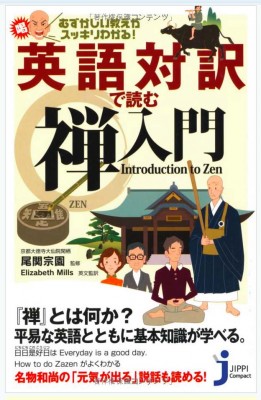 英語対訳で読む禅入門, or Introduction to Zen with Accompanying English Translation, was written by Priest Souen Ozeki and translated by a one Elizabeth Mills (whom I suspect may be using a pen name, as the translation is not native). As stated in the preface, the book was intended for both English speakers interested in the religion and Japanese speakers interested in the English terms for Zen method.
英語対訳で読む禅入門, or Introduction to Zen with Accompanying English Translation, was written by Priest Souen Ozeki and translated by a one Elizabeth Mills (whom I suspect may be using a pen name, as the translation is not native). As stated in the preface, the book was intended for both English speakers interested in the religion and Japanese speakers interested in the English terms for Zen method.
Introduction to Zen attempts to clarify the following subjects: the history of Buddhism (and specifically the development of Zen), the basic underlying concepts, the rituals and practices, and the ways in which Japanese culture is intertwined with the religion. The book also has a chapter outlining some of the major players in the history of Zen in Japan.
The cover boasts that this text conveys the content’s “difficult ideas” clearly (むずがしい考えがスッキリ分かる!); though if this leads you to expect something other than the usual interpretation of Zen – non-linear, meandering, parabolic explanations- you will be disappointed. My western brain still struggles to grasp the style typical of Zen masters, their purportedly didactic riddles often leaving me with more questions than answers.
Often, it’s a confusing read. In the beginning, Priest Ozeki devotes a chapter to the importance of maintaining “a pure heart”, without bothering to explain what a pure heart looks like, or the nature of the maintenance required. This is just one of many vague instructions listed for living a Zen life; others include “being present in the moment” and keeping a “free mind, one which is not influenced by anything”. Ozeki further complicates things a few chapters later when he decides to mention that “Zen is not a thing to think about but is training. You can not attain enlightenment even if you read many books and study hard.” Resisting the urge to question why I am reading a book about a subject the author himself has just declared *actually* requires field study, I decide to remain open to his attempts to explain the concept of Enlightenment and corresponding parable:
“Enlightenment could be explained as having the same mental condition as the Buddha had when he attained enlightenment under the Bodhi Tree. Enlightenment can be attained when you clean up your mind which is ordinarily messy. Zen training strips away fixed ideas and prejudices and reorganizes the mind. Now I quote one story. In the Meiji period, a scholar visited a training hall in Tokyo to see (a famous master). The master, listening to the scholar, poured tea into a cup. He continued to pour even after the cup was full. The scholar said: ‘Master! The tea is overflowing’. The master answered: ‘Yes. It is similar to you. Your mind is filled with study and there is no room for what I tell you.’ This story explains Zen very well.”
*eyes widen, glaze over*
It only after finishing the entire text that I gleaned what might be the unstated assumption: like a religion, there are values by which Zen abides. However, practitioners believe these values can only be discovered through the practice of Zen, rather than the study.
Without trying to assist the author by creating a framework in which the pieces more or less fit, much of the book’s teachings comes off like the wisdom of “Mystery Men”s the Sphynx: “In order to go down, you must first go up.” I fear this might be unavoidable; the consensus seems to indicate that Zen can not be comprehended using the tools of logic, but must be “observed”. Only those who tough it out for the requisite decades might stand a chance. But who has the time, anyway? We can’t all sit around on tatami mats, reinventing the wheel. Give up the answers already!!
Despite this infuriating quality, the book certainly has some merits.
The way the book is written is by far its best attribute. As you can see to the left, the difficult and Zen-related words are translated underneath the English. Additionally, more abstract phrases (such as “within one’s self” and “the more you X, the more you Y”) that one doesn’t often come across in daily language are also translated, making this a very useful reference for expressions of personal conviction, which are difficult to learn in this language for cultural reasons.
And on the following page, there is a Japanese translations of the entire preceding text. This is a rather enjoyable way to learn or even just reinforce Japanese skills.
And while the book doesn’t do much to clarify the murkier aspects of Zen, the practices of the religion and the lives of the monks are very clearly explained, and with handy illustrations.
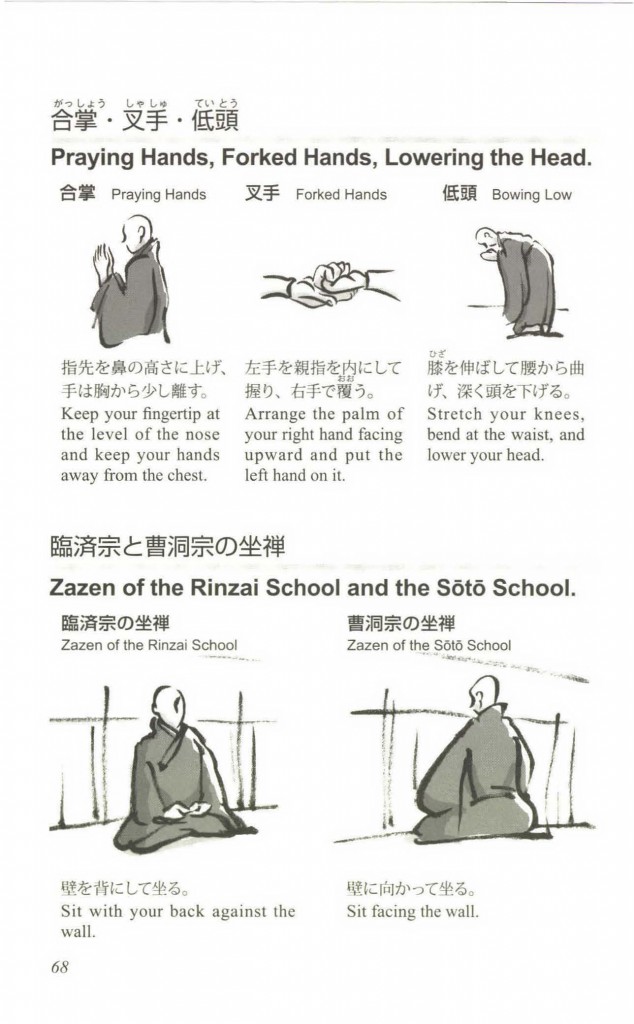
And in case you ever visit a temple, and are suddenly struck on the back, you will know “how to” do it!
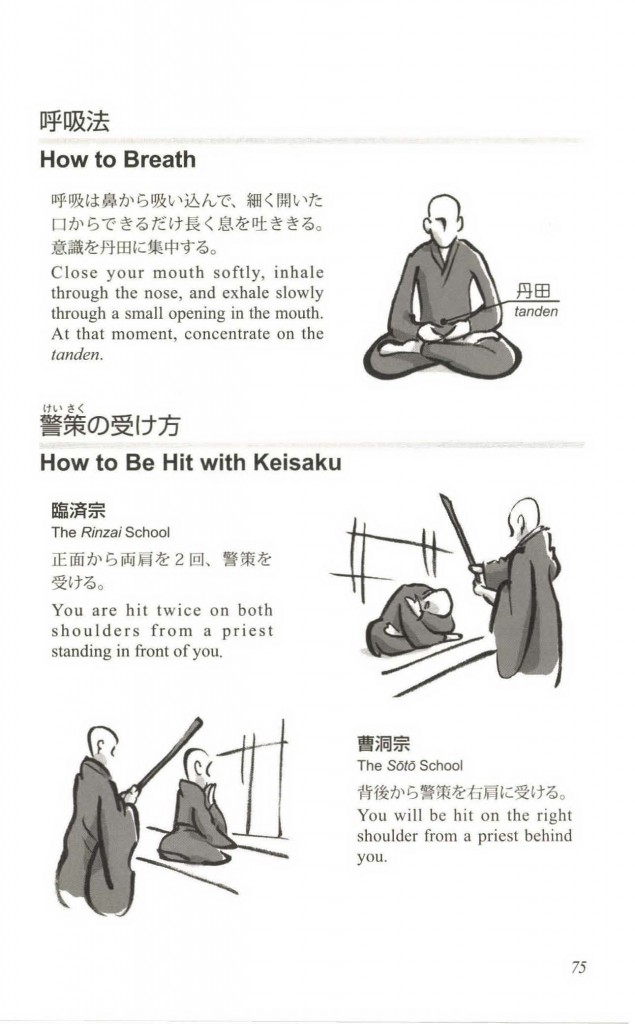
Unfortunately, the “history of Zen” area and the profiles of the Zen masters could have been written with a little more flavor; they are only slightly more exciting than the endless genealogy lists of the Torah. However, if you are interested in the life of a priest and the rituals involved in Zen practice, this book I found to be unique in its descriptions of Japanese monastery life, one which, if you are not proficient in the Japanese language, you may only find here.
The book can be bought on Amazon.jp : Introduction to Zen
Jake’s Review Of the Book:
I have a slightly different take on this book than Nakajima-san, but then again I lack objectivity which is why she was the better person to do the first review. I lived in a Soto Buddhist Zen Temple for three years in college and meditated every day. This book is full of great little zen sayings and anecdotes but it doesn’t quite explain the differences between the two major sects of Zen Buddhism. Soto Buddhism, founded by Dogen, essentially looks at Satori (悟り)or enlightenment as a mental state that one can reach through the practice of meditation on a regular basis and remaining centered and aware in daily life. Zazen (座禅) or Zen meditation itself is like a powerful herb–it can be used as medicine or poison. The technique has been show to actually increase activity in the parts of the brain that control behavior and physically change the structure of the brain over time. By being aware of our anger, our greed, and our motives as we act–we can overcome those passions and be better people. However, without motivation or ethical guidelines or commitment to those precepts, zen can just become a tool for being a more efficient killer. I suggest that any Zen Buddhist neophyte read Zen At War for a sobering look at how Zen Buddhism was perverted by the Japanese military rulers for use in the Second World War. It also has some touching stories of those few Zen Buddhists who stood for peace and against the inhumane acts inflicted by the Japanese Imperial Troops and wartime regime.
It’s often glossed over but a Zen Buddhist priest in the Soto Buddhist tradition takes a vow to uphold ten ethical precepts (重十誡). If I could uphold these for a day, it would be a very good day.
Not to kill but to nurture life.
Not to steal but to receive what is offered as a gift.
Not to misuse sexuality but to be caring and faithful in intimate
relationships.
Not to lie but to be truthful.
Not to intoxicate with substances or doctrines but to promote
clarity and awareness.
Not to speak of others’ faults but to speak out of loving-kindness.
Not to praise self at the expense of others but to be modest.
Not to be possessive of anything but to be generous.
Not to harbor anger but to forgive.
Not to do anything to diminish the Triple Treasure but to support
and nurture it.
I don’t know anyone who can live up to those precepts, except maybe the Dalai Lama. “Not to speak of others’ faults but to speak out of loving-kindness” almost precludes journalism as a career. (LOL). Ultimately, when you put the mystic mumbo jumbo aside, the goal of Zen Buddhism, especially in the Soto School–is to be come a living Buddha, a Bodhisattva (菩薩), who is a beneficial force in the world. Bodhisattvas are men and women committed to the welfare, liberation, and enlightenment of all sentient beings.
Zen master Dogen, in one of his lesser known writings, sums up the teaching of the religion rather elegantly in his essay: The Four Integrative Methods of Bodhisattvas (Bodaisatta shishaho). The purpose of zen meditation is to enable the practitioner to live up to these ideals. At least, that’s my understanding of it. But then again, I’m not enlightened.
The four integrative methods of bodhisattvas are giving, kind speech, beneficial action, and cooperation. This giving means not coveting; not coveting is not being greedy. Kind speech means that in looking upon living beings one shoulfirst arouse a mind of kindness and love and should utter caring, kind words. It is the absence of harsh speech. In ordinary social convention there is the etiquette of asking if someone is well or not; in Buddhism there is the expression “take care” and the ethical conduct of asking how someone is. To speak with the thought in one’s heart of kindly minding living beings as one would a baby is kind speech. Beneficial action means to employ skills beneficial to living beings, high and low. For example, one watches over the road far and near, working out means to benefit others. One should pity even an exhausted turtle and take care of an ailing sparrow. When one hasseen an exhausted turtle or an ailing sparrow, one doesn’t want their thanks-one is simply moved to helpful action. Fools think that when benefit to others is put first, one’s own benefit will be reduced. It is not so. Beneficial action is one principle; it is universally benefiting self and others. Cooperation means nonopposition. It is not opposing oneself and not opposing others. For example, a task of cooperation is a manner, is a standard, is an attitude. After regarding others as self, there must be a principle ofassimilating oneself to others. Self and others are endless with time. (adapted from Shobogenzo.:Zen Essays by Eihei Dogen, translated by Thomas Cleary)
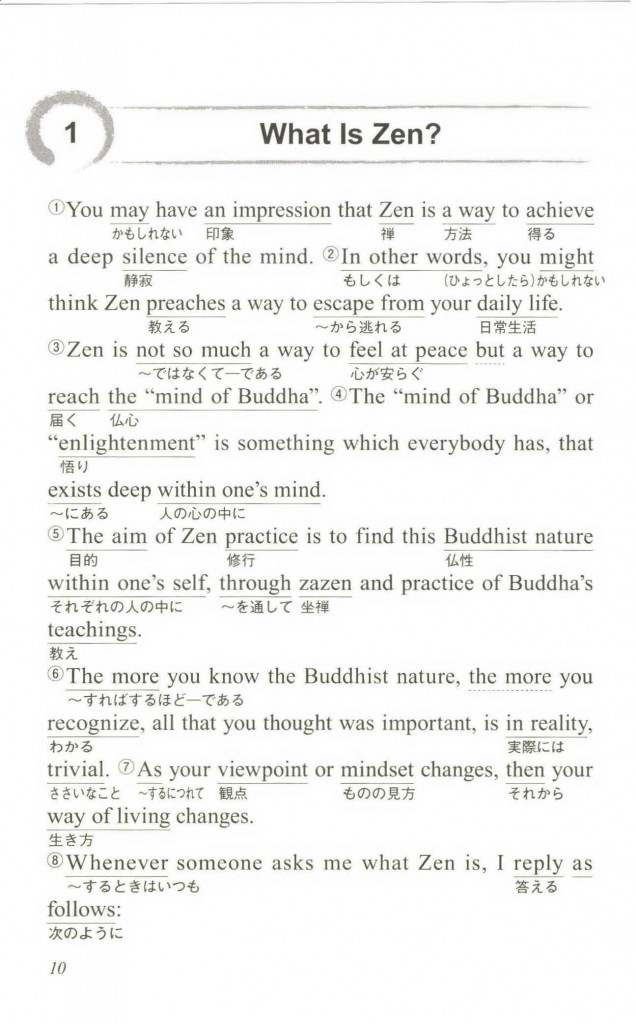
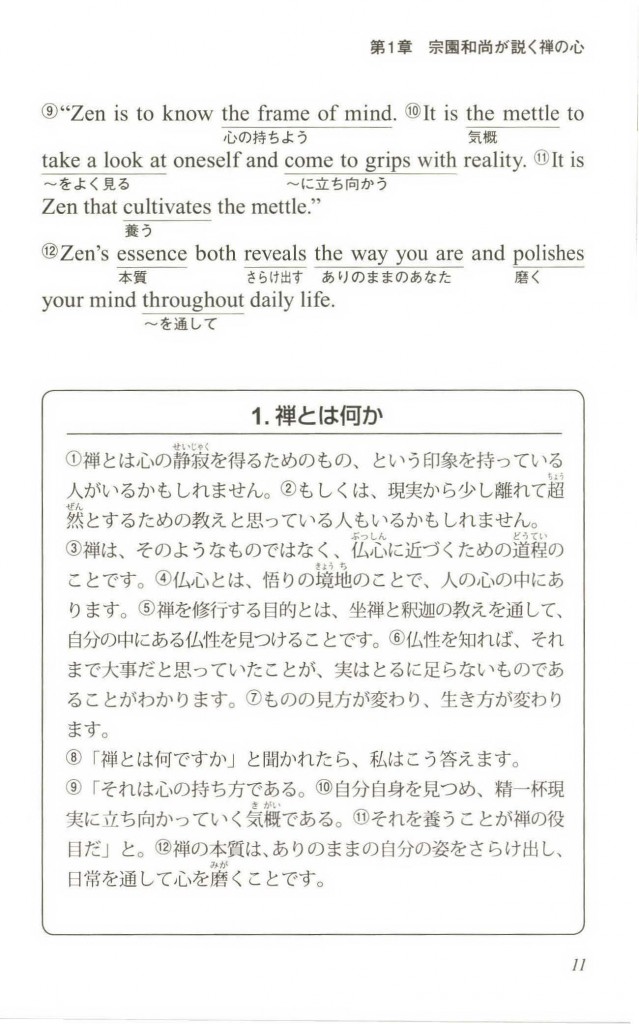
Where might I buy this book? is it only available in Japan?
“I fear this might be unavoidable; the consensus seems to indicate that Zen can not be comprehended using the tools of logic, but must be observed”
> I am not in Japan since a long time (about a year) but I have the impression that this sentence loosely define the learning process as it is understood in Japan.
It is particularly clear in some martial arts (e.g. aikido), where the trainee starts to exercise without much of an explanation. Some explanations comes along the way, with comments and correction, but it is mostly a personal journey to understanding. That can be extremely frustrating when you are used to the occidental style of teaching, where explanations come before application.
Such an attitude w.r.t. learning allows to understand why at work you can be “dropped” in front of a problem you never met before (and you have no prior knowledge) without much more than a “gambaru”.
Greetings Chris!
So sorry, I forgot to include a link to amazon. Unfortunately, it is only sold on Amazon Japan, for ¥800. I have included the link above.
V.B.-
Good observations! I didn’t know this about Japanese martial arts. Isn’t it odd that these traditions are still maintained, while in the same country children are expected to go to “cram school” until all hours of the night?
Ah… Zen… I suggest works by Nishida Kitaro if you want something that applies more logic to it… but it is, in its essence, a philosophy of being and doing, not one of logic and reason…
Still, I feel there is an underlying truth to it if only I could stop thinking long enough to figure it out.
Kudos to the Mystery Men reference… major bonus points… One of the most underrated movies of the 90s…
Looking forward to more of your posts, reviews
I’ll pass this along to Ms. Nakajima. Yes, The Mystery Men reference was stellar. She has great tastes in pop culture. If she would only learn to respect and admire her 先輩 more, she would be the perfect person. (LOL)
Not sure, but I think that The Japanese have a different understanding of the descriptive and emotive meaning of words and terms. I think that this should be taken into consideration.
Stephanie Nakajima says: 29 November 2011 at 11:50 pm
“Isn’t it odd that these traditions are still maintained, while in the same country children are expected to go to “cram school” until all hours of the night?”
I’m sure a zen master would have an answer to this conundrum! It’s obvious, of course, which form of “discipline” has won out. But then Japan has never been a “religious” nor particularly introspective society.
[…] “Zen actually resides in every facet of the Japanese mind,” writes Masuno, and the foremost instance of that’s seen in the best way we work. “The dedication to craftsmanship and the reverence for precision and self-discipline is unparalleled.” He additionally factors out the endearing peculiarities of the Japanese aesthetic, and the way it revels within the flawed and incomplete. Proof to that’s seen within the imperfect, spontaneous power of a Zen backyard. Or how the Japanese refuse to throw out cracked bowls and plates, however will discover a option to mend them with gold mud. Masuno writes, “Ruptures, cracks, creases and wrinkles — the Japanese will discover magnificence in these flaws as a result of Zen is a philosophy that accepts and finally forgives all the things.” […]